December 2016
Poem by Jessie Murdoch
We circle round with Rose and Lynne dancing all the way,
We dance with grace and gusto when we hear the music play,
Slip step here – slip step there, we’ll get it right one day,
Sway to right – sway to left as we dance the hours away.
Happy when we meet again, smiles seen all around,
With grapevines, nappy walks and stamps, are you sure we’re here to dance?
A partner dance we have to do in a mysterious Grand Chain,
How many people have I passed? I’ve got it wrong again!
We have our favourite dances and ones we’d rather not,
But we dance each one in laughter with friends who mean a lot.
We share our joys and sadness, bringing added blessings to our group,
As the seasons pass along the year, we celebrate throughout.
The demonstrations we are shown, but did we understand?
The music starts – here we go – we got it right – Hoorah!!
What is that our teachers say -they’ve put in another bit?
“In your head – count two quiet beats….then loudly shout OLE!!”
Calypso helps us dance the seas to find and view the Source.
We tell a Winter’s Tale when Dancing in the Roses, of course.
We hear the Bells of Norwich then say our sweet refrain,
‘May the Circle be open, but unbroken’ until we meet again.
Jessie Murdoch, December 2016, Kinross & Cupar Circle Dancing Group
October 2016
Circle Dance: The Deep History by Ben Bailey
Some fifteen years ago, towards the end of a long illness, my therapist, Sylvia Hollingworth — now, sadly, no longer with us — invited me to try circle dance. Once I had begun to overcome the two-left feet syndrome, I was astonished by the spiritual impact. In fact, I had what I can only describe as a spiritual experience during the Vivaldi/Friendship dance — an overwhelming sensation of beauty.
Now, I am, to trade, an engineer/scientist — a down-to-earth “nuts and bolts” man — and my curiosity was fully aroused. Where on earth does this stuff come from? And, of course, other than very short term recent history, and mere speculation, no-one could tell me.
I first discovered Jesus’ invitation to the disciples to dance around him — The Hymn of Jesus — in the New Testament Apocrypha: Acts of St John; and later I then found the earlier poem by Sappho of women dancing.
More recently, I casually Googled “prehistoric dancing” and was amazed to get a hit on a book: “Dancing at the Dawn of Agriculture” by Prof. Yosef Garfinkel, Department of Biblical Archeology, at the Hebrew University of Jerusalem, and published by the University of Texas, 2003.
On first opening the book, I was stunned to see images of women dancing in V, or W, hand-holds depicted on sherds dating from as much as ten millennia before the present (BP).
The book is divided into two parts: The Dance Analysis and The Data. The latter is a compilation of nearly 400 images from archaeological artefacts. These show that the depictions of dance were, at first, literal portraits, and then later became severely stylised over the six millennia that they appear. Subsequently, dance images were replaced with depictions relating to the emergence of organised authority.
In The Dance Analysis section the author’s view is that, at that time, coinciding as it does with the earliest beginnings of agriculture, small communities created internal cohesion, and the very necessary synchronism with the seasons, through the ritual of circle dance. These rituals were recorded on pottery. In his analysis the author draws in data from ethnology and from the etymology of Middle Eastern languages.
Of course, one absolutely has to have music to accompany dance, and here too the archaeological evidence is strong and exists in the form of surviving wind instruments. The records are dispersed in the literature, but the most striking is the article in Nature, 460, pp737-740, 6 August 2009, “New flutes document the earliest musical tradition in southwestern Germany”, authors N.J. Conard, M. Malina, S.C. Munzel. This article describes the discovery of the fragments of a total of 8 flutes, variously made from mammoth ivory, swan bones, and a wing-bone from a griffon vulture, all dating to not later than 35,000 years BP.
Elsewhere, there is a fragment, found in Slovenia, of a supposed flute made from a bear thigh-bone and dating to 43,000 years BP. Some critics contend that the finger-holes are but carnivore tooth perforations but the holes are nicely circular – they look to have been very neatly drilled – and a flautist, Jelle Aterna, showed that it was a part of a flute by very competently playing a replica.
In addition, there are 22 flutes from the French Pyrenees dating from 20,000 to 35,000 years BP, and finally there is a single flute from Austria dating to 19,000 years BP.
And then I encountered the following in an article, in the journal New Scientist, by Prof. Robin Dunbar, who leads the Institute of Cognitive and Evolutionary Anthropology at Oxford University.
“Over the past two million years, there seems to have been increasing pressure to evolve ever-larger social groups. Based on the social brain hypothesis, I have calculated that our social group size should be around 150. This has come to be known as “Dunbar’s number” and turns out to be both a common community size in human social organisations and the typical size of personal social networks. But how could humans and their immediate ancestors have sustained groups that greatly exceed the number that can be bonded by grooming?”
“It seems we have exploited three additional behaviours that are very good at triggering the release of endorphins but can be done in groups, allowing several individuals to be “groomed” at the same time. First came laughter, which we share with the great apes. Essentially a form of chorusing, laughter typically involves a group of three people, making it more efficient than grooming as a bonding mechanism. Next, perhaps 500,000 years ago, we added singing and
dancing, which increased the grooming group still further. Finally, language gave greater control over both laughter – through jokes – and song and dance.”
https://www.newscientist.com/article/mg22229700-400-friendship-do-animals-have-friends-too/
These ideas are much expanded in Prof. Dunbar’s book: Human Evolution, Pelican, 2014, — which includes an extensive academic bibliography. Importantly, he shows the endorphin (feel good factor) release effect, outlined in the New Scientist article, to be confirmed through ingenious experiments on cooperating people. In particular, he shows the enhanced bonding effect of synchronised communal activity from, for example, drumming, or singing, or dancing.
I would like to express my deepest gratitude to all my dancing friends for this fascinating and very rewarding journey of discovery. I have no doubt that we have been dancing in a circle since we emerged as anatomically modern humans 200,000 years ago; thus superseding the very much older dancing of our archaic human predecessors.
August 2016
Francesca Stridgen and ‘A Flavour of Findhorn’ by Keryn Evely

It was good to have Francesca back in Auchterarder after a gap of two years. ‘A Flavour of Findhorn’ had first been scheduled for August 2015 but due to an injury Francesca was unable to come that year.
So it was after this year’s Festival of Sacred Dance, Music and Song, marking the 40th anniversary of Bernhard Wosien’s first visit to Findhorn that we had our little taste of what happens there.
Francesca brought with her a photograph taken at the 2014 Festival that showed the resident dance teachers Laura Shannon, Peter Vallance and Susanne Anders Bartholomai along with that year’s guest Piry Krakow.
The guest teacher for 2016 was Nanni Kloke and Francesca aimed to give us at least one dance that would have been taught (or even choreographed by) each of these teachers. Eighteen dancers came for the session held in the afternoon of August 28th at Three Kings’ Hall, Ochil Tower School in Auchterarder.
Francesca spoke about the different aspects of the festival, the opportunities to sing in the choir, join the scratch band or to dance from morning until night!
She also gave us some insights into the different teachers and their commitment: whether travelling to research traditional dances or choreographing and teaching new ones along with the awareness and integrity the different teachers bring to their teaching and training courses.
We danced Trehantiraki (The Little Boat) and Hora la Galana from the new CD ‘Limani’ by Laura and Kostantis. We danced Roma dances that Piry had introduced in 2014 and also Peter’s choreography to Om Namah Shivaya.
Peace of the Healing Light (choreographed by Nanni Kloke) is a powerful yet accessible dance that I was very glad to dance again. Francesca’s skilful teaching of both the steps and the context and meaning of the dances was greatly appreciated. A dancer who had been at the Festival for the first time this year wrote:
‘It was lovely to be taught Deep Peace again, in a more peaceful environment, and with room to really stretch without fear of daunting anyone. Hats off to Francesca for teaching it from memory….wow! The other dances were a real flavour of Findhorn too.’ Pamela
Another dancer who was encountering these dances for the first time wrote:
‘I really enjoyed Sunday. I liked how Francesca wanted to give a strong sense of the dance and really get the feel of it, it was very grounding. Francesca has wisdom and empathy that came over very strongly to me.’ Stella
I, for one, shall be looking forward to my next trip to Findhorn Festival, where on the final evening we dance to live music and singing by the choir as well as welcoming Francesca back for her annual visit!
Afternoon Tea Circle Dance, Dollar


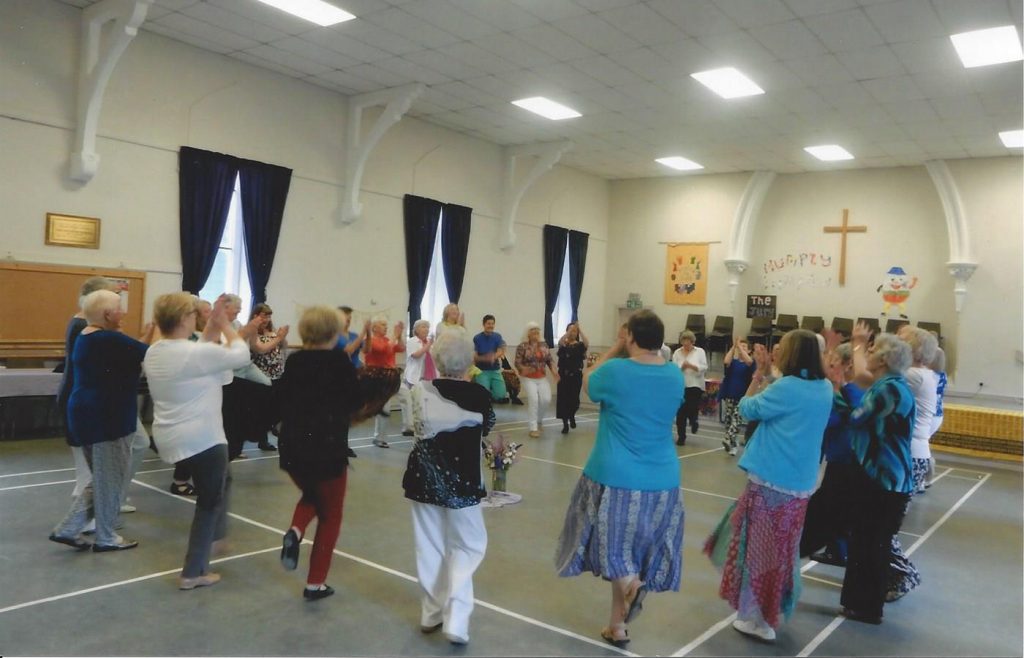
July 2016
Teachers’ Share Day
June 2016
A Labyrinth in Kinburn Park, by Jo Freeman

There is a closely guarded secret in Kinburn Park, St Andrews. A beautiful Labyrinth, recently constructed by volunteers and completed about 3 months ago.
In recent years, there has been a resurgence of interest in the labyrinth, a place for personal meditation and possibly spiritual transformation. It can be used as a walking meditation, a way to finding your own spiritual centre, a body prayer.
There is no right or wrong way to walk or dance a labyrinth. It is a powerful tool to illuminating one’s path through life.
The location in Kilburn Park which is administered by Fife Council gives easy access in a lovely place. A number of ladies who were participating in a ‘Circle Dance’ weekend on Saturday 18th June in University Hall Kennedy
Gardens, happened upon the Labyrinth and were delighted to be able to dance within it.
Circle dancing is a form of dance enjoyed throughout the world, the dances have a wide variety and form and mood from slow and meditative to frankly energetic and celebratory, they are suitable for all abilities and you do not need a partner.
Mandy de Winter, St Andrews






May 2016
Circle Dance by Anne Greenshields
As a newcomer to Auchterarder, I was keen to meet people and find new interests. I had always been interested in dance and before moving to Auchterarder, had enjoyed many different types of dance class – my highlight was dancing with Wayne Sleep who was taking a tap dancing class!
So when I spotted a poster in the local Co-op – “Enjoy Dancing?” “Like World Music?” and the answer to both questions was “Yes”; I made a note of the phone number and contacted Keryn who explained a bit about Circle Dancing.
I decided to give it a try and went along to my first session – not quite knowing what to expect as I had never heard of Circle Dance before.
The group gave me a very warm welcome, everyone was so friendly. As I had joined the group a few weeks into the term/session I was a bit concerned that I might have had to play “catch up” with other members who had already learned the steps and dances, but I need not have worried.
Both Keryn and Elke, the teachers were (and still are!) so helpful and the other dancers also showed me the steps. Although at first I really did have to concentrate, never able to take my eyes off Keryn’s feet, after a few weeks I found I was able to start enjoying the rhythm of the dance and music.
So what types of dance and music are involved?
They originate from countries and cultures around the world encompassing a rich and diverse range of dances and songs some of which celebrate special occasions in the community.
The music can literally be from anywhere in the world; European countries, Africa, Russia, India, South and North America …
It ranges from traditional folk, classical, Latin-American to contemporary and lots in between!
For instance I have recently danced to music from 13th century Spain, to an African peace chant, a thanks giving dance from Israel as well as to music by Capercaillie, JS Bach and John Denver.
Most of the dances we do in a circle with hands joined, some we dance with hands un-joined. You don’t need a partner although partners are welcome to join in. Other than comfortable shoes no special dress required.
Circle Dance is lovely gentle exercise and I always leave the class with a feeling of well being. When I get home my partner always comments “You look happy, “which is how I always feel after Circle Dancing.
May 2016
Barbara Driscoll, Sauchie & Auchterarder
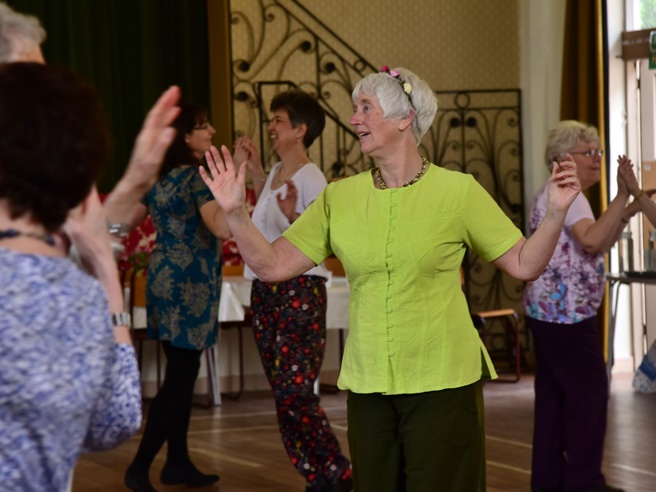

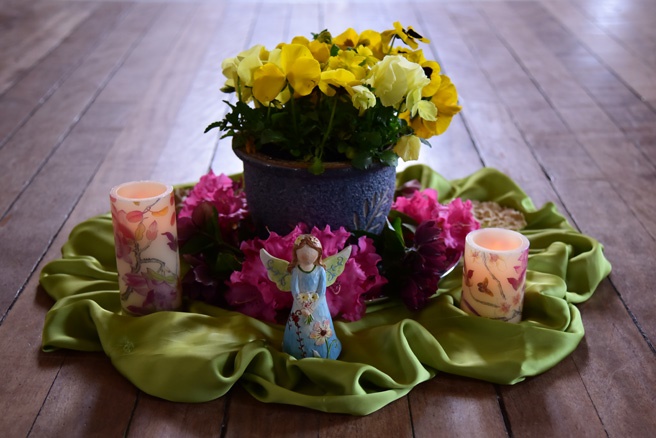
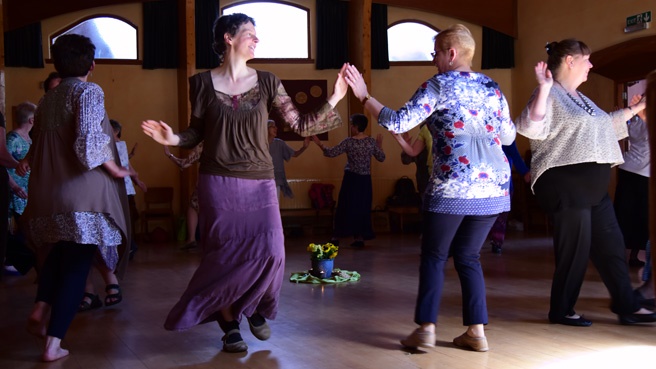
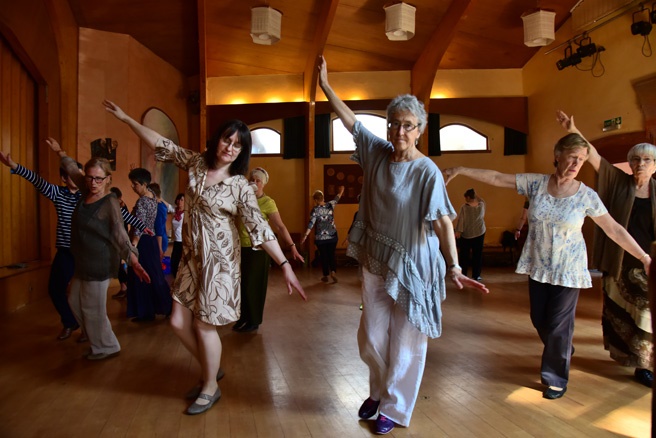
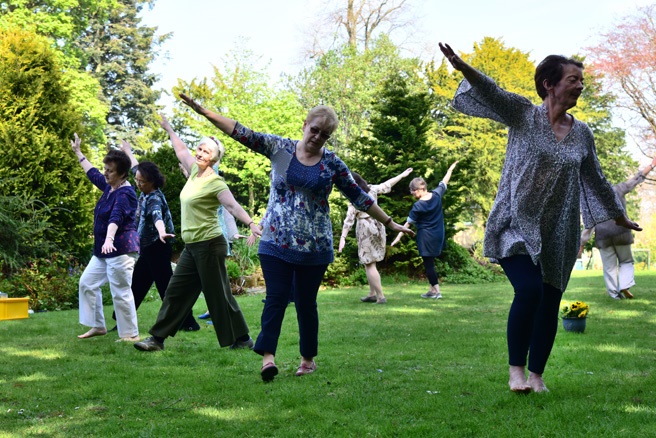
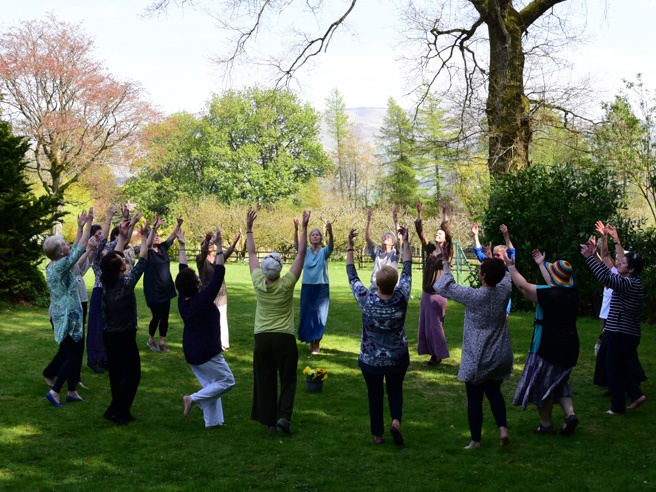
April 2016
Article by Diana Treffry
Did you watch ‘How to stay Young’ (two parts, shown 7 and 14 April on BBC2)?
They investigated different types of exercise and compared their effectiveness: table tennis as against walking; dancing against going to the gym. It could just be that because she trained as a dancer, Angela Rippon, the presenter (aged 71), was a tad biased, but dancing came out as the best form of exercise. And of course I’m not biased at all when I say that circle dancing reaches those parts of the body, mind and spirit that other forms might not, and as well, it’s sociable and fun and the music’s wonderful!
So if you catch sight of yourself in the mirror looking older than you’d like, dust off your dancing shoes and come along.
March 2016
Zodiac Day, Auchterarder by Keryn Evelyn

On Sunday March 20th, coinciding with the Spring Equinox, 23 dancers came together at Three Kings’ Hall, Auchterarder for a day of dance themed around the signs of the Zodiac.
This dance day was first ‘aired’ in 2008, inspired by the beautiful pictures in a calendar that I had purchased the previous year.
Not knowing very much at all about astrology I consulted a knowledgeable dancer who was then part of our group, read the book she lent me, and came up with a sequence of dances.
We started the morning in Aries and danced through the signs until Pisces, completing our journey with the Sun Meditation Dance.

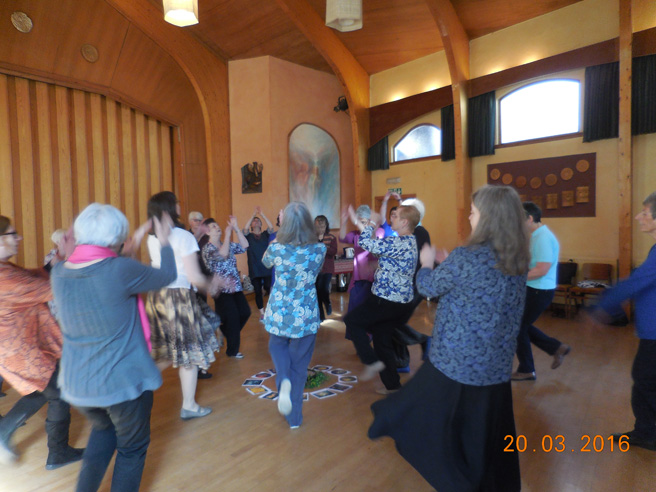
The pictures show us dancing a partner dance (with lots of opportunity for communication) for Gemini, as well as Kwaheri and Healing Fire Dance for Leo.
Apart from the urn deciding not to work, the day went really well and we raised £212 for Marie Curie.
Pictures: K Evely and M Dunning
Zodiac Day, Auchterarder by Carol Holtom
This turned out to be a very special day for me, and an apt herald of the spring equinox.

At the beginning, Keryn reminded us of the links between the cycle of nature and the cyclical nature of the zodiac.
Thanks to her impressive and extensive preparations, we were given a summary of the characteristics of each zodiac symbol, from Aries to Pisces, and as we moved round the cycle, one by one candles were lit by the dancers born under that particular sign.
Lynne gave a hilarious address* to those aspiring to teach dance to participants from different astrological signs.
There was a diversity in the choice of dances which had been chosen to reflect the associated energies of each particular sun sign: dances to music from different nationalities – Greek, Armenian, African, Scottish and Israeli amongst them. There was also a diversity in pace: some joyful and energetic, some meditative or lyrical, others stately or courtly. We also experienced the different, but effective, teaching styles of Keryn, Elke, Lynne, Maria and Rose. Diverse elements seemed to flow into a harmonious whole.
It struck me that we were celebrating the individual – the dancers, the teachers, the dances, all different yet all equally valuable – at the same time as celebrating our connectedness in being part of the dance and part of the greater cycle.
*Madame Nawal’s ‘Astrological Advice Service to Circle Dance Teachers’ which first appeared in Grapevine Autumn 1993


